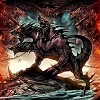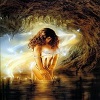Lamia
The child-eating daemon
Lamia was apparently a beautiful queen of Libya who became a child-eating daemon.
In the myth, Lamia is a mistress of the god Zeus, causing Zeus' jealous wife, Hera, to kill all of Lamia's children (except for Scylla, who is herself cursed) and transform her into a monster that hunts and devours the children of others. Another version has Hera stealing all of Lamia's children and Lamia, who loses her mind from grief and despair, starts stealing and devouring others' children out of envy, the repeated monstrosity of which transforms her into a monster.
The overall story goes like this:
Lamia was named as either a daughter of Poseidon, or of Belus, who himself was a son of Poseidon. Lamia would be named as a beautiful queen of Ancient Libya, the region west of the Nile.
The beauty of Lamia was such that Zeus was attracted to her, and the god successfully seduced the queen, who subsequently gave birth to several children by the god. Hera soon learned of her husband’s infidelity and sought her revenge by stealing away the children born to Lamia.
The loss of her children causes Lamia to go mad, and so the Queen of Libya kidnaps the children of others, and eats them. The monstrous actions of Lamia cause her facial features to distort, possibly mimicking that of a shark, and Lamia becomes a monster herself.
The story of Lamia was the equivalent of the bogeyman tales of more recent history, and as a result many embellishments were made to the basic story. Some versions have Hera killing the children of Lamia, or causing Lamia herself to kill the children and then devour them.
Some accounts say she has a serpent's tail below the waist. This popular description of her is largely due to Lamia, a poem by John Keats composed in 1819. Antoninus Liberalis uses Lamia as an alternate name for the serpentine drakaina Sybaris; however, Diodorus Siculus describes her as having nothing more than a distorted face.
Later traditions referred to many lamiae; these were folkloric monsters similar to vampires and succubi that seduced young men and then fed on their blood.
In later stories, Lamia was cursed with the inability to close her eyes so that she would always obsess over the image of her dead children. Some accounts (i.e. Horace) say Hera forced Lamia to devour her own children. Myths variously describe Lamia's monstrous (occasionally serpentine) appearance as a result of either Hera's wrath, the pain of grief, the madness that drove her to murder, or—in some rare versions—a natural result of being Hecate's daughter.
Zeus then gave her the ability to remove her eyes. The purpose of this ability is unclear in Diodorus, but other versions state Lamia's ability to remove her eyes came with the gift of prophecy. Zeus did this to appease Lamia in her grief over the loss of her children and to let her rest since she could not close her eyes.
Interpretations:
Mothers throughout Europe used to threaten their children with the story of Lamia. Leinweber states, "She became a kind of fairy-tale figure, used by mothers and nannies to induce good behavior among children."
Many lurid details were conjured up by later writers, assembled in the Suda, expanded upon in Renaissance poetry and collected in Bulfinch and in Brewer's Dictionary of Phrase and Fable: Lamia was envious of other mothers and ate their children. She was usually female, but Aristophanes suggests a hermaphroditic phallus. Leinweber notes, "By the time of Apuleius, not only were Lamia characteristics liberally mixed into popular notions of sorcery, but at some level the very names were interchangeable." Nicolas K. Kiessling compared the lamia with the medieval succubus and Grendel's mother in Beowulf.
Apuleius, in The Golden Ass, describes the witch Meroe and her sister as lamiae: "The three major enchantresses of the novel—Meroe, Panthia and Pamphylia—also reveal many vampiric qualities generally associated with Lamiae," David Walter Leinweber has noticed.
One interpretation posits the Lamia may have been a seductress, as in Philostratus' Life of Apollonius of Tyana, where the philosopher Apollonius reveals to the young bridegroom, Menippus, his hastily-married wife is really a lamia, planning to devour him. Some harlots were named "Lamia". The connection between Demetrius Poliorcetes and the courtesan Lamia was notorious. In the painting by Herbert James Draper (1909), the Lamia who moodily watches the serpent on her forearm appears to represent a hetaera.
Although the lower body of Draper's Lamia is human, he alludes to her serpentine history by draping a shed snake skin about her waist. In Renaissance emblems, Lamia has the body of a serpent and the breasts and head of a woman, like the image of hypocrisy.
Christian writers warned against the seductive potential of lamiae. In his 9th-century treatise on divorce, Hincmar, archbishop of Reims, listed lamiae among the supernatural dangers that threatened marriages, and identified them with geniciales feminae, female reproductive spirits.
John Keats described the Lamia in Lamia and Other Poems, presenting a description of the various colors of Lamia that was based on Burton's in The Anatomy of Melancholy. The Keats story follows the general plotline of Philostratus, with Apollonius revealing Lamia's true nature before her wedding.












